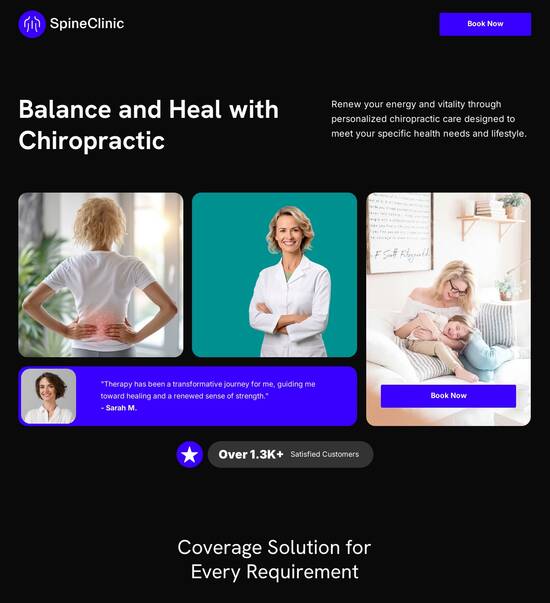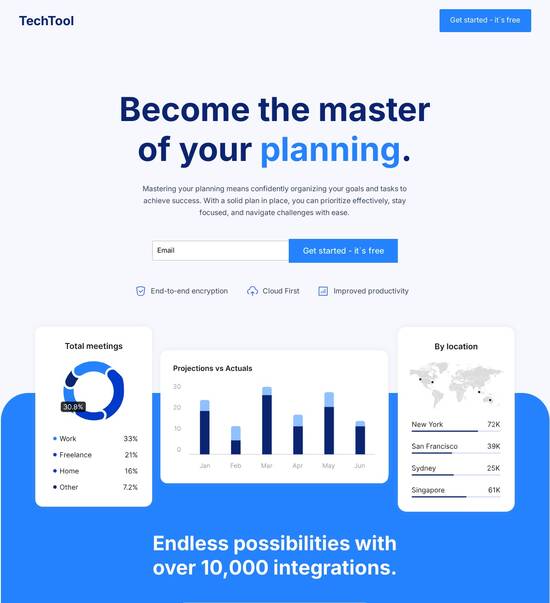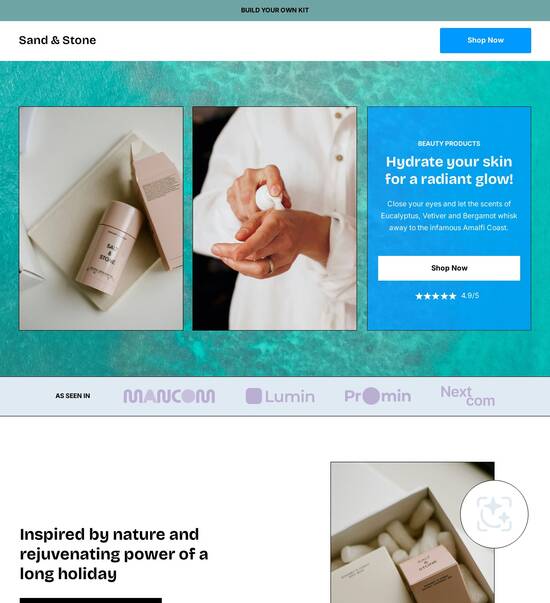
HTML page template with interactive terms and conditions form
Explore Similar TemplatesAbout template
Use HTML page templates with interactive terms and conditions form and make your communications easy and transparent. Try our solution today.
Recommended templates

Easy to build without coding
With the intuitive drag-and-drop builder, anyone on your team can create high-converting pages without any knowledge of code or design. Make enhancements to your landing page with custom widgets using Javascript, HTML/CSS, or third-party scripts.

Multiple layouts for any industry and goal
Select from 500+ landing page layouts built to boost conversions across industry-specific scenarios. Customize them by adjusting fonts, adding images, and generating on-brand content with the AI assistant. Quickly scale with Instablocks® and Global Blocks that you can save, reuse, and update globally.

Loads fast and looks polished on any device
Every template is responsive, which means they present professionally on any device and load blazingly fast with our Thor Render Engine. You can also power them up with Google AMP technology to deliver an unparalleled mobile experience and drive higher conversions.

Robust analytics & experimentation
Get real-time updates and reporting across all your devices, showing the number of visitors, conversions, cost-per-visitor, and cost-per-lead. Launch AI-powered experiments, run A/B tests, and use heatmaps to analyze user behavior, then optimize your landing page to maximize conversions.







Easy to build without coding
With the intuitive drag-and-drop builder, anyone on your team can create high-converting pages without any knowledge of code or design. Make enhancements to your landing page with custom widgets using Javascript, HTML/CSS, or third-party scripts.
Multiple layouts for any industry and goal
Select from 500+ landing page layouts built to boost conversions across industry-specific scenarios. Customize them by adjusting fonts, adding images, and generating on-brand content with the AI assistant. Quickly scale with Instablocks® and Global Blocks that you can save, reuse, and update globally.
Loads fast and looks polished on any device
Every template is responsive, which means they present professionally on any device and load blazingly fast with our Thor Render Engine.
Robust analytics & experimentation
Get real-time updates and reporting across all your devices, showing the number of visitors, conversions, cost-per-visitor, and cost-per-lead. Launch AI-powered experiments, run A/B tests, and use heatmaps to analyze user behavior, then optimize your landing page to maximize conversions.
All the features you need to build terms and conditions html template
Explore more featuresLearn how to build top-performing landing pages for any goal
FAQs
Leading the way in building high-performing landing pages





Enhance your marketing campaigns with Instapage's powerful landing page platform
Instapage is designed to supercharge your digital marketing efforts. With its robust landing page and Conversion Rate Optimization (CRO) capabilities, marketers in various industries can create and optimize high-converting landing pages that yield impressive returns on investment (ROI). This step-by-step guide will walk you through leveraging Instapage to maximize your campaign effectiveness in sectors like business services, education, and financial services.
Understanding the importance of landing pages
Landing pages play a crucial role in guiding potential customers through the sales funnel. By targeting specific audiences and tailoring messages, you can significantly improve conversion rates. Here are key benefits of utilizing Instapage for your landing page needs:
- Higher conversions: Customized landing pages cater to specific audiences, increasing the likelihood of lead generation.
- Enhanced user experience: With fast-loading and responsive designs, you can ensure a seamless visitor journey.
- Data-driven optimization: Instapage provides analytics and A/B testing tools that enable continuous monitoring and testing.
Step 1: Choosing the right template
Instapage offers over 100 high-converting templates designed for various industries. Selecting the appropriate template for your campaign is the first step toward building an effective landing page. Consider the following:
- Industry relevance: Pick templates that reflect your unique business sector, be it tech, education, or marketing.
- Conversion-oriented designs: Focus on layouts that are proven to drive conversions.
- Ease of customization: Ensure the template allows for easy edits to fit your specific messaging.
Step 2: Personalizing your content
Personalization can significantly impact user engagement. With Instapage, you can create dynamic experiences tailored to specific audience segments. Here’s how to do it:
- Dynamic text replacement: Automatically insert keywords based on user data to match their search intent.
- Utilize AdMaps: Align specific ads with unique landing pages seamlessly.
- Monitor your audience metrics: Use data tools to analyze how different segments interact with your content.
Step 3: Optimizing for conversions
Once your landing page is live, it’s crucial to analyze and optimize it for better performance. Instapage provides several built-in features to facilitate this.
- Conduct A/B testing: Experiment with different headlines, images, and calls to action to determine what resonates best with your audience.
- Utilize heatmaps: Visualize user behavior on your page to identify areas for improvement.
- Integrate analytics: Track performance metrics to inform ongoing adjustments and enhancements.
By following these steps, you can leverage Instapage to create powerful, converting landing pages that engage your audience effectively.
Ready to take your campaigns to the next level? Start using Instapage today for a hands-on approach to landing page optimization and see your ROI soar.
People also ask about HTML page template with interactive terms and conditions form
Creating an HTML page template with an interactive terms and conditions form
Setting the stage: Understanding the importance of terms and conditions
Terms and conditions serve as a critical foundation in digital interaction, providing essential legal protections and guiding user experiences. Firstly, the role of terms and conditions is to protect both the user's rights and the company’s liability. This dual function fosters a sense of safety as users navigate through services and offerings. Establishing clear policies can lead to enhanced trust, as users appreciate transparency and are more likely to engage when they understand the rules.
Moreover, the legal implications surrounding terms and conditions are substantial. Compliance with regulations not only safeguards businesses but also aligns with ethical practices that users expect. Various case studies illustrate the fallout from vague terms, including costly legal disputes that many companies face. As online platforms proliferate, rigorous attention to comprehensible terms is indispensable.
Designing the interactive terms and conditions form
Crafting a compelling HTML template is vital for any interactive terms and conditions form. A well-structured HTML page typically includes key components such as a clear title, content sections, and a form. Each element needs to be easily identifiable, which aids both user experience and accessibility. Additionally, it’s crucial to implement responsive containers, ensuring the form is usable across various device sizes. Responsive design not only enhances usability but aligns with best practices in web development.
Furthermore, employing CSS for styling can significantly elevate the user experience. CSS allows designers to create visually appealing forms that guide users through content seamlessly. Incorporating hover effects and smooth transitions captures attention and encourages interaction. Aesthetic elements, coupled with functional design, lead to a user-friendly experience where users feel compelled to engage with the content.
Deep dive into the interactive features
User-friendly interface design is paramount when constructing terms and conditions forms. A straightforward interface helps mitigate confusion, guiding users effectively through policies without overwhelming them. Strategies such as breaking down lengthy text into digestible chunks, utilizing headings, and adding visual elements create a harmonious balance. This attention to detail can significantly influence user engagement and acceptance of terms.
One innovative approach involves incorporating a sliding terms acceptance feature. This mechanic invites users to engage actively, creating a more memorable interaction than traditional acceptance methods. The benefits of such interactive acceptance mechanisms include reduced cognitive load and increased satisfaction as users navigate the form. Additionally, features like dynamic responses deliver real-time validation results, simplifying the process while offering instant reassurance.
Crafting a DIY guide to building your own interactive terms and conditions form
To create an interactive terms and conditions form, a step-by-step approach ensures all bases are covered. Begin by choosing the right HTML structure—selecting appropriate elements and attributes for clarity. Utilizing HTML form elements such as input types, labels, and buttons enhances accessibility. Each component must serve a specific purpose, making navigation straightforward for users.
Incorporating CSS for a beautiful interface follows this structural foundation. Employing best practices in styling forms—including typography, color schemes, and spacing—ensures clarity and engagement. Choosing effective color palettes and layouts supports a cohesive user experience where visual elements guide user focus organically toward critical components.
Finally, JavaScript plays a significant role in enhancing interactivity. Simple scripts can manage common form behaviors, like validating user input and triggering visual confirmations. Implementing modal pop-ups summarizing terms before acceptance provides users with essential information, preventing misunderstandings. This feature ensures users are well-informed before making a commitment.
Common pitfalls and how to avoid them
Designing forms presents certain pitfalls that developers must navigate carefully. One common mistake involves overloading users with excessive initial information, which can lead to disengagement or frustration. A strategic approach, breaking large blocks of text into smaller, manageable sections, enhances comprehension and keeps users engaged. Additionally, ensuring that designs are mobile-optimized is essential, as many users will encounter forms on various devices. This includes refining breakpoints for visual consistency.
Neglecting accessibility features is another critical misstep. Accessibility is crucial; it tailors experiences for all users, including those relying on assistive technologies like screen readers. Ensuring that labels and roles are included explicitly within HTML elements promotes inclusivity. Functionality should extend to all users, ensuring your terms and conditions form is practical for everyone.
Furthermore, avoiding legal missteps is paramount. It is essential to consult legal professionals during the formulation of terms to ensure clarity and completeness. Confusing language in terms may lead to future disputes, and businesses should err on the side of transparency to prevent misunderstandings.
Enhancing user experience: The art of feedback and communication
Immediate feedback plays a vital role in enhancing the user experience. Implementing strategies that provide timely confirmation messages helps users confirm their actions, fostering a sense of satisfaction. For instance, color-coded notifications can indicate successful inputs or highlight errors, making it easier for users to rectify mistakes. Visual feedback, particularly in digital forms, is an essential part of ensuring user confidence throughout the interaction.
Maintaining engagement during the completion of terms and conditions forms is equally important. Utilizing visual cues such as progress indicators keeps users informed about their completion status. Additionally, incorporating interactive elements enhances user interest while ensuring they are not overwhelmed. An effective balance of information and interactivity can significantly improve user acceptance rates.
Integrating the sign-up form: A seamless user journey
Connecting terms acceptance directly to sign-up flows is an effective strategy for reducing drop-off rates. This integration ensures that users can quickly and efficiently move through the process while facilitating necessary consent. Clear prompts and messaging around terms acceptance contribute to transparency, bolstering user commitment and promoting user engagement with the overall platform.
From a technical perspective, tracking user interactions through JavaScript and backend systems can provide valuable insights into user behavior. Monitoring how users engage with terms and conditions helps identify friction points and opportunities for optimization. By analyzing this data, businesses can iterate on their forms, continuously improving the user experience and enhancing overall satisfaction.
Real-world applications and case studies
Successful implementations of interactive terms and conditions forms can be found across various industries. For instance, e-commerce sites often utilize engaging forms to ensure customer compliance, while software platforms leverage interactive features to educate users on their terms. Health services provide similar strategies, enhancing transparency regarding patient rights, reflecting diverse applications of this concept.
Analyzing user engagement metrics offers deeper insights into how users interact with terms and conditions. Data regarding completion rates, average time spent on forms, and feedback can inform ongoing improvements. Identifying key performance indicators—such as bounce rates or revisions—offers an avenue for measuring success and elucidating areas that may require further refinement.
Future trends: Where terms and conditions forms are heading
The role of AI and machine learning stands at the forefront of enhancing terms and conditions experiences. Personalizing terms for individual users, based on previous interactions or preferences, not only improves compliance but fosters a sense of relevance. Predictive text and auto-completion features based on user behavior can streamline interactions further, creating a more tailored experience.
As legal requirements evolve, businesses must adapt to meet changing user expectations for transparency and engagement. Staying informed about shifts in regulatory landscapes will help companies modify their approaches, ensuring compliance while providing valuable user experiences. Businesses that leverage the latest tools and trends will find themselves at a significant advantage.
Capturing the essence of interactive terms and conditions form
Achieving a balance between legal requirements and user experience is a continuous endeavor in crafting effective terms and conditions forms. By focusing on customer-centric design, businesses can create a product that fulfills legality seamlessly while facilitating user engagement. This equilibrium promises a smoother user journey, ultimately fostering trust and compliance.
The realm of innovative interfaces presents opportunities for experimentation and ongoing improvement. Encouraging developers and designers to explore and share success stories not only benefits individual projects but cultivates a community centered on creativity. This collaborative spirit will motivate the evolution of terms and conditions forms, ensuring they remain relevant and effective.
Ready to skyrocket conversions?
Supercharge your ad campaigns with high-performing landing pages
Get started














